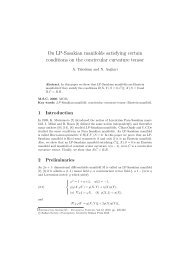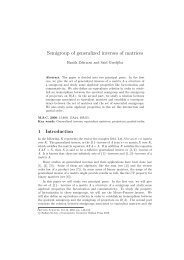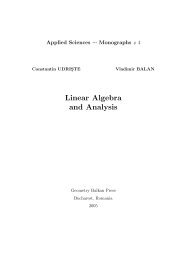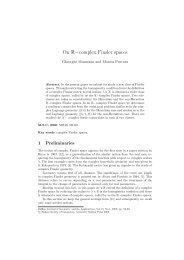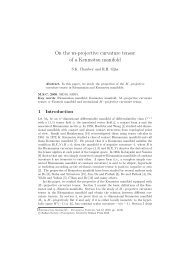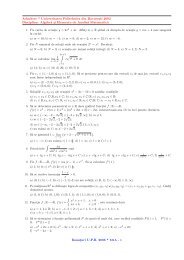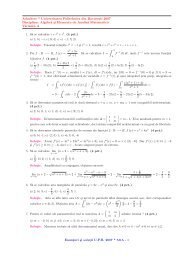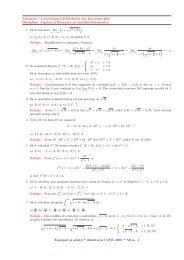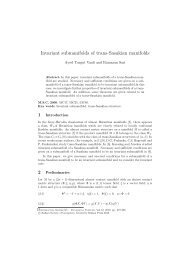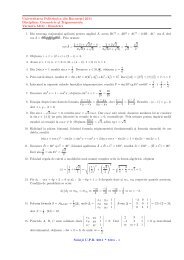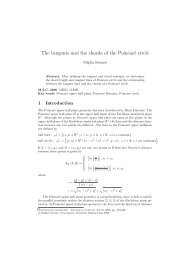Minimal surfaces in the 3-dimensional Heisenberg group
Minimal surfaces in the 3-dimensional Heisenberg group
Minimal surfaces in the 3-dimensional Heisenberg group
You also want an ePaper? Increase the reach of your titles
YUMPU automatically turns print PDFs into web optimized ePapers that Google loves.
164 Jun-ichi Inoguchiwith multiplication:(x 1 , x 2 , x 3 ) · (˜x 1 , ˜x 2 , ˜x 3 ) = (x 1 + ˜x 1 , x 2 + ˜x 2 , x 3 + ˜x 3 + λ 2 (x1˜x 2 − ˜x 1 x 2 ) ).The unit element of G(λ) is ⃗0 = (0, 0, 0). The <strong>in</strong>verse element of (x 1 , x 2 , x 3 ) is−(x 1 , x 2 , x 3 ). Obviously, G(0) is <strong>the</strong> abelian <strong>group</strong> (R 3 , +).The Lie algebra g(λ) of G(λ) is R 3 with commutation relations:(1) [E 1 , E 2 ] = λ E 3 , [E 2 , E 3 ] = [E 3 , E 1 ] = ⃗0with respect to <strong>the</strong> natural basis E 1 = (1, 0, 0), E 2 = (0, 1, 0), E 3 = (0, 0, 1). Theformulae (1) imply that g(λ) is nilpotent. The left translated vector fields of E 1 , E 2 ,E 3 aree 1 = ∂∂x − λy ∂2 ∂z , e 2 = ∂ ∂y + λx ∂2 ∂z , e 3 = ∂ ∂z ,respectively.We equip an <strong>in</strong>ner product 〈·, ·〉 on g(λ) so that {E 1 , E 2 , E 3 } is orthonormal withrespect to it. Then <strong>the</strong> result<strong>in</strong>g left <strong>in</strong>variant Riemannian metric g = g λ on G(λ) is(2) g λ = (dx 1 ) 2 + (dx 2 ) 2 + ω ⊗ ω,where(3) ω = dx 3 + λ 2 (x2 dx 1 − x 1 dx 2 ).The one-form ω satisfies dω ∧ ω = −λdx 1 ∧ dx 2 ∧ dx 3 . Thus ω is a contact form onG(λ) if and only if λ ≠ 0.The homogeneous Riemannian 3-manifold (G(λ), g λ ) is called <strong>the</strong> 3-<strong>dimensional</strong><strong>Heisenberg</strong> <strong>group</strong> if λ ≠ 0. Note that (G(0), g 0 ) is <strong>the</strong> Euclidean 3-space. Thehomogeneous Riemannian 3-manifold (G(1), g 1 ) is frequently referred as <strong>the</strong> modelspace Nil 3 of <strong>the</strong> nilgeometry <strong>in</strong> <strong>the</strong> sense of Thurston [9].2 Matrix <strong>group</strong> model of G(λ)The Lie <strong>group</strong> G(λ) is realised as a closed sub<strong>group</strong> of <strong>the</strong> general l<strong>in</strong>ear <strong>group</strong> GL 4 R.In fact, G(λ) is imbedded <strong>in</strong> GL 4 R by ι : G(λ) → GL 4 R;⎛⎞e x1 0 0 0ι(x 1 , x 2 , x 3 ) = ⎜ 0 1 λx 1 x 3 + λ 2⎝x1 x 2⎟0 0 1 x 2 ⎠ .0 0 0 1Clearly ι is an <strong>in</strong>jective Lie <strong>group</strong> homomorphism. Thus G(λ) is identified with⎧⎛⎞⎫e ⎪⎨x1 0 0 0⎜ 0 1 λx 1 x 3 + λ 2⎝x1 x 2⎪⎬⎟0 0 1 x ⎪⎩2 ⎠ ∣ x1 , x 2 , x 3 ∈ R .⎪⎭0 0 0 1



